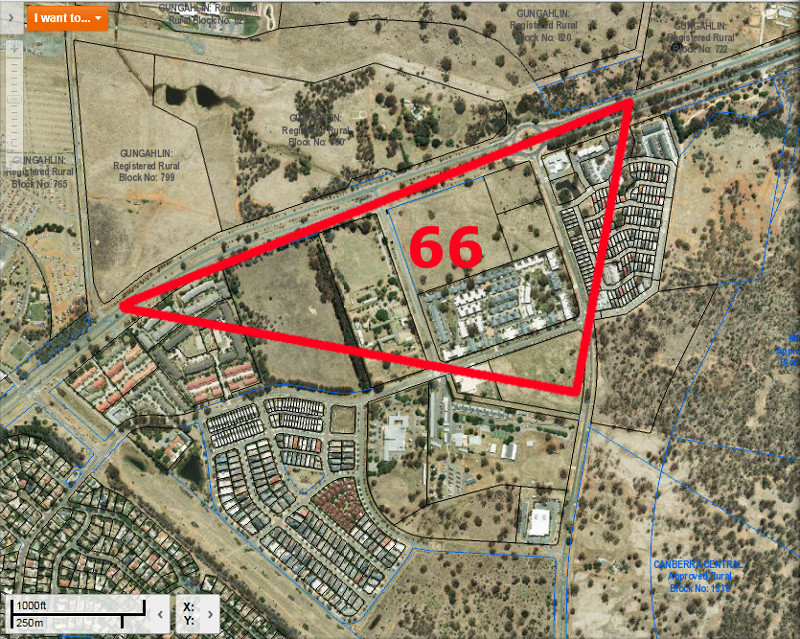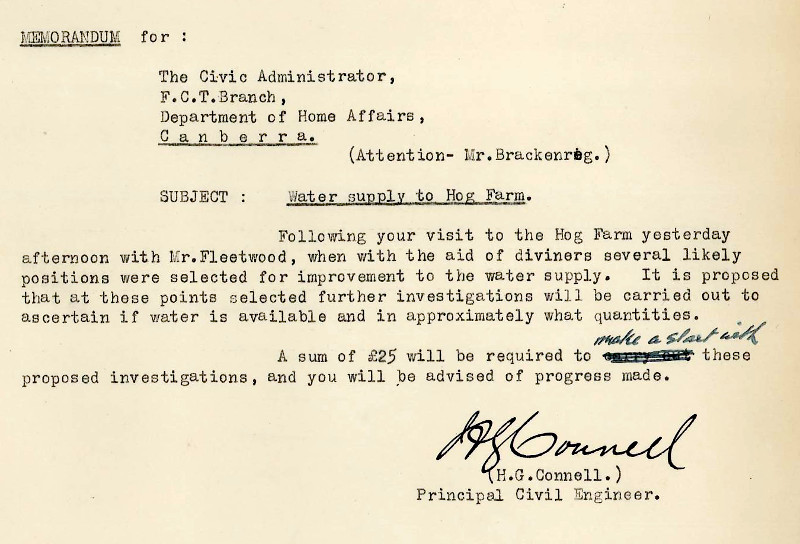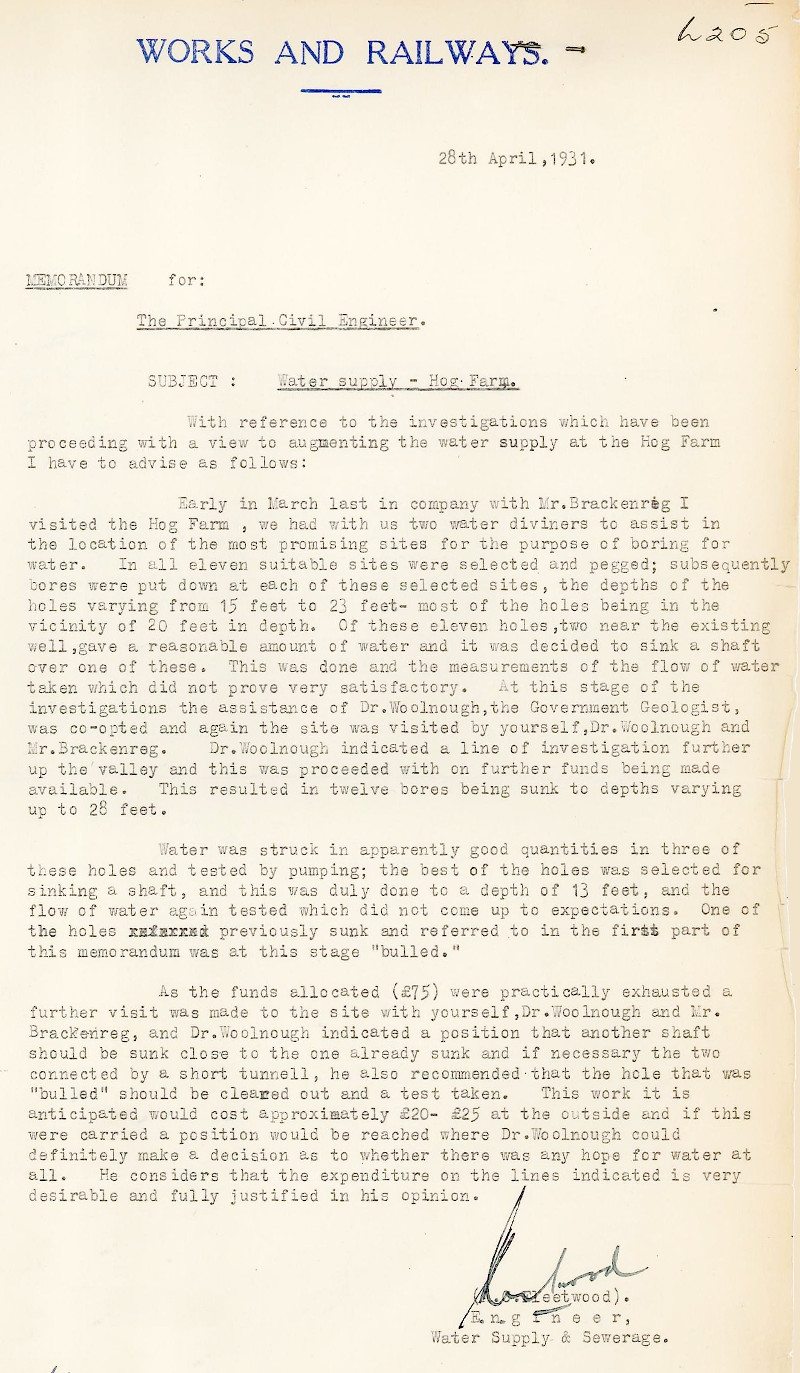Previous find of the month
October 2015
The Hog Farm
"The National Capital's Greatest Industry"

One of the things considered essential in the 1920s for the establishment of a brand new city like Canberra was, perhaps surprisingly, a pig farm. This history of the Federal Capital Commission's 'Commonwealth Stud Farm,' more commonly known as the "Hog Farm", covers a saga of
ancient mystical powers, interdepartmental warfare, prize-winning pigs and perhaps Canberra's first foray into agritourism.
The file 'TL7764: Department of the Interior - Planning and Development Branch - Block 66 Gungahlin - Hog Farm' is this month's ArchivesACT Find of the Month.
Creating a Hog Stud Farm
The Hog Farm was operational from 1929 until 1956. It primarily bred pigs for meat but also became an effective food waste disposal system for Canberra, and even had prize winning pigs at the Sydney Royal Easter Show. The FCC intended the new Hog Farm, operating under modern scientific principles, would replace an earlier farm situated beside Woolshed Creek close to Duntroon. A Health Officer who inspected the earlier farm noted it was located "immediately above a long stretch of stagnant water into which ran the drainage from the farm." In January 1928, the FCC had selected a new site north of the City at the foot of Mount Majura. However, the area of this block was deemed as insufficient space for all the pigsties. The Surveyor-in-Charge suggested the larger Gungahlin Block 66, 400m further north, situated beside the Federal Highway in what is now North Watson.
Gungahlin Block 66 had several advantages over the block originally selected:
"There is far more space for disposal of any washing wastes. The area is well protected from the west and south. The area is about a quarter of a mile further north than the original site, and has the advantage of being further away from the creek and embraces a good cultivation paddock."

The approximate location of Gungahlin Block 66 on a 2014 aerial view of North Watson.
In February 1928, the Acting Chief Engineer undertook investigations into the block's water supply:
"A spring existed in the locality, and a divining rod expert had traced an apparent underground watercourse which originated just above the spring and worked through it and down into the valley and thence backwards and forwards across the creek."
The FCC decided that it would construct the farm, but its operation would be put out to tender. The Commonwealth Stud Farms Limited was the successful applicant, with Mr Alexander Coles as the farm's manager who was involved with the planning and construction of the Hog Farm from the early stages. A discussion held between Coles and the FCC on 29th August 1928 outlines, "subject to Mr Coles' wishes", the overall requirements for the Hog Farm including:
- farrowing, fattening, boar and hospital pens
- cooking block, with fodder and bedding stores
- garbage block, with tool & vehicle shed and stables
- paddocks for growing pigs
- movable shelters
- shelters for breeding sows
- concrete feeding floors
- fencing and pig lanes
- water supply and drainage
- boiler and food cooking plant
Final approval for the farm was given on 6th October 1928 with an "amount of £5,550 be expended in establishing a Hog Farm, and provided in the estimates for 1928-1929 in an amount of £2,500". In January 1928, the FCC had projected that construction of the farm would take approximately three months; work was finally completed by early October 1929 and at total cost of £6,676. The first pigs, 24 sows and one boar, arrived from Victoria on the 31st of October 1929.
The Hog Farm served the dual purposes of providing pork goods and the assisting with the disposal of up to six tons per day of 'wet waste'. Wet waste was kitchen scraps collected from Canberra's hotels and hostels by the Hog Farm lessees. After cooking in large coppers, it was used as pig feed. For the farm to operate efficiently, it would require a great deal of reliable water and good drainage systems.
"The Water Supply Will Be Quite Satisfactory"
Even before the Hog Farm had commenced full operation, the water supply was of great concern. Only a couple of days after the final approval to build was given in October 1928, Lands Officer James Brackenreg suggested that before any work commenced, "do you not think it advisable that a test should be made of the well which is to be the source of the temporary water supply?"
A reliable, high volume water supply is essential for the hygienic rearing of pigs. Coles stated that 100 pigs required 675 gallons (3069 litres) for drinking and garbage sterilisation per day. An additional 1575 gallons (7160 litres) was "required to serve 21 pens for wallow and bath purposes." Despite the FCC Development Committee's assurance in November 1928 that, "...the water supply will be quite satisfactory", the farm's dam had dried up by January 1929. The FCC had the dam cleaned out and enlarged in the hope of preventing this occurring again.
However, in November 1929, only a month after the farm began full operation, Veterinary Officer A.C. McKay stated, "It is my opinion that the water supply will, at an early date, require supplementing..." This prompted Brackenreg to request another test of the well's capacity. It produced 1800 gallons (8183 litres) over eight hours on two consecutive days.
In January 1930, Coles reported the well's yield as only 700 to 800 gallons (3182 to 3637 litres) a day, a quantity insufficient to support his farm's capacity of 500 pigs. He later admitted that he could obtain at least 1000 gallons (4546 litres) a day from the well, but this quantity was still insufficient to carry out all the clauses of his lease agreement with the FCC.
By February 1930, Coles complained to Veterinary Officer McKay "...that his pigs were dying of thirst...". McKay inspected the farm and found the well had two inches (61cm) of water and the taps were working, despite Coles' report that the pump was giving him trouble. McKay did find one dead pig but was unable to determine cause of death due to it "being partly incinerated".
Brackenreg believed that Coles was "financially embarrassed" and "endeavouring to make up some case against the Commission so that he may have an action at law." Brackenreg added, "There may be nothing at all in this but it is my opinion based on rumours coming from a fairly good source."
In May 1930, the FCC arranged for the Department of Works and Railways to increase the well's capacity at the cost of £50.
The water supply was not the only concern with the farm. The FCC had not completed drainage work by August 1930 due to alterations in the plans and insufficient funding. The Director General of Health strongly urged that the drainage be completed. Brackenreg recommended that a pig expert from NSW, Mr A.F. Gray, visit and report on the hog farm scheme.
Gray first assisted the FCC in advising on a suitable site in April 1928 but had not returned to Canberra since. Despite being "considerably impressed", his report did contain a number of recommendations for improvement, including aspects of the drainage and water supply. Gray recommended that:
"The Acting Chief Engineer investigate and develop a scheme for 2,000 gallons per day. Water from all roofs to be caught and stored for domestic purposes and for drinking supply to hogs."
"With the Aid of Diviners"
It was in March 1931, when Brackenreg again reported, "...the spring from which the water supply at this farm is drawn has failed absolutely...". This resulted in the costly requirement to cart in water collected from the City mains. On the 10th of March, Brackenreg, in the company of Works and Railways engineer A.C. Fleetwood and two water diviners, visited the Hog Farm to locate likely positions for a new well.

Memo from Principal Engineer, H.G. Connell to Brackenreg dated the 11th March 1931.
Brackenreg also reported on his visit in a memo to the Civic Administrator dated the 12th of March 1931:
"The result of my visit to the farm on Tuesday with the Engineer and certain persons who are supposed to have some knowledge of finding water as a result of the divining rod, was - certain positions were located, and I arranged, subject to your approval, for certain boring operations to take place in order to test whether or not there is any water at the spots indicated."
He recommended £25 made available for the boring operations as:
"The position is so serious that this money must be expended, otherwise we will have to close down the Hog Farm, for the Government and Coles could never afford the present cost of carting water from the City mains."
In April 1931, the Department of Works and Railways sunk test bores in the eleven sites selected by the diviners. Engineer Fleetwood reported on the findings:
"In all eleven suitable sites were selected and pegged; subsequently bores were put down at each of these selected sites, the depths of the holes varying from 15 feet to 23 feet [4.6m to 7m] - most of the holes being in the vicinity of 20 feet [6.1m] in depth. Of these eleven holes, two near the existing well, gave a reasonable amount of water and it was decided to sink a shaft over one of these. This was done and the measurements of the flow of water taken which did not prove very satisfactory."
The FCC then consulted the Government Geologist, Dr Woolnough, who indicated a line of investigation further up the valley. That resulted in the sinking of twelve further bores to depths varying up to 28 feet [8.5m].
"Water was struck in apparently good quantities in three of these holes and tested by pumping ; the best of the holes was selected for sinking a shaft, and this was duly done to a depth of 13 feet [3.96m], and the flow of water again tested which did not come up to expectations. One of the holes previously sunk and referred to in the first part of this memorandum was at this stage "bulled.'' [enlarged]

Memo from Engineer, A.C. Fleetwood dated the 28th April 1931.
The Department of Works carried out another investigation of the test shafts in May 1931. After clearing out the bulled hole, they found it to be "...practically full of water." They also sunk an additional three shafts at this time. After further investigations in November 1931, the
Department of Works installed and filled five 5000-gallon (22,730 litre) water tanks at the cost of £180 for use during extended dry spells.
Early 1932, The Commonwealth Stud Farms Limited replaced Coles with Mr R.A. Guthridge as the Hog Farm manager. They also proposed the extension of Canberra's water supply to the Hog Farm around this time. In June 1933, the Department of the Interior reported on this proposal:
"An estimate has been prepared namely £2,200, for the construction of a water supply to the Hog Farm which would be feasible after the completion of the Black Mountain Reservoir. Also a guaranteed consumption from the Lessee of 32,000 gallons [145,475 litres] per week, or 1,664,000 gallons [7,564,697 litres] per annum at the present gazetted rate of 1/3d per thousand gallons has been received."
The ACT Advisory Council, on Brackenreg's recommendation, rejected the extension of the water supply to the Hog Farm.
Page: 1 2
